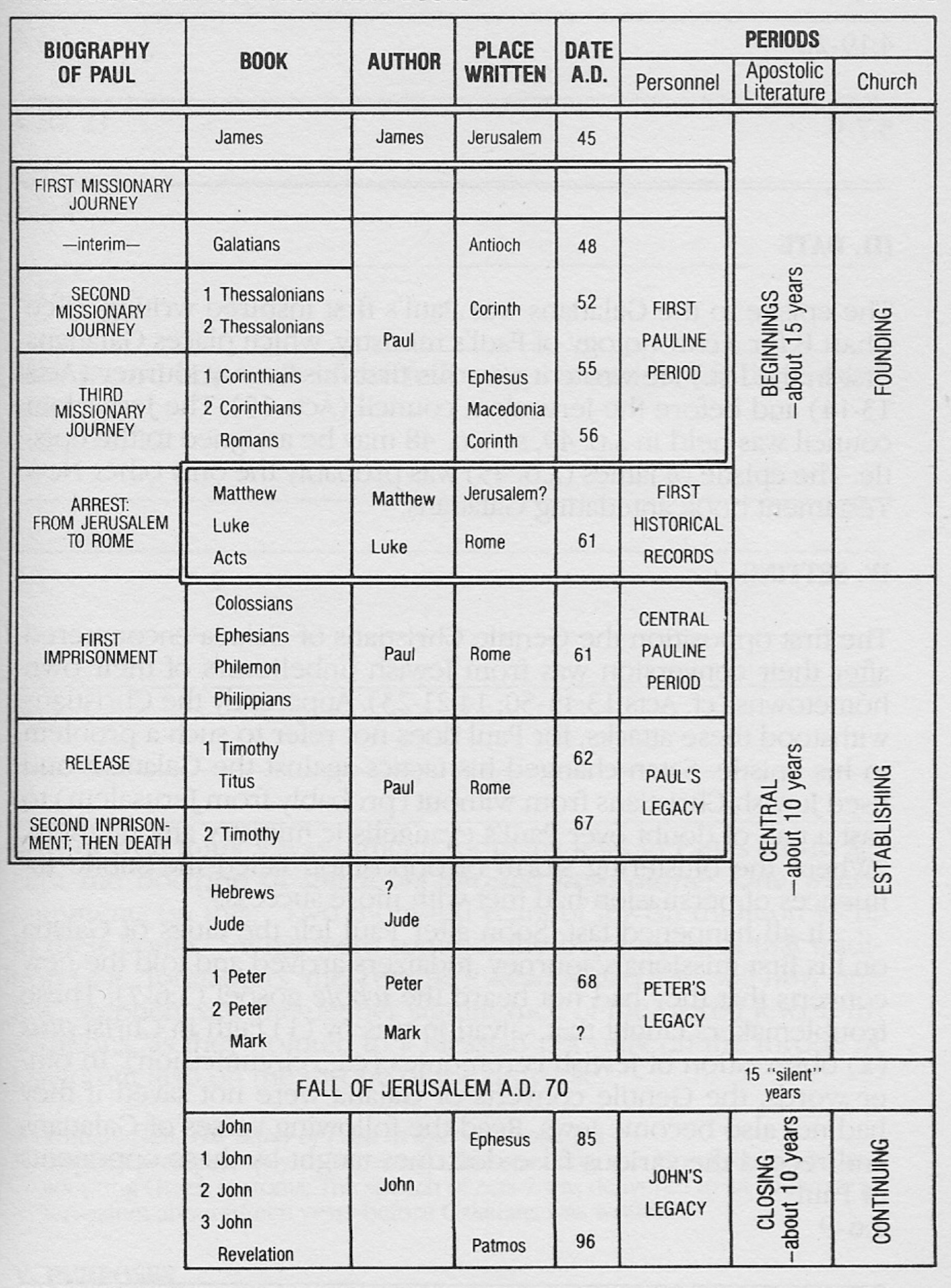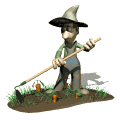INTRODUCTION TO 3 JOHN
Irvine L. Jensen
The Moody Bible Institution of Chicago
copyright © 1969
Used by permission.
QUESTIONS FOR STUDY ONE
OUTLINE

Before analyzing the test of any book of the Bible, it is well to learn the historical background.
Also, it is best to make a "skyscraper" view of its general contents. Accordingly, this introduction is divided into two parts: background and survey.
- BACKGROUND
- Author.
Internal evidence and early church tradition give ample support to the view that the apostle John wrote the epistles as well as the fourth gospel.* Arguments favoring another author, such as a different John with the designation "John the elder," are not as strong.
Identification of the author of the fourth gospel is narrowed down to the one man John the apostle when one considers the following descriptions of the author (Note: Study this section not only for the identification of authorship, but also to learn more about John, the person):
- HE WAS A PALESTINIAN JEW. This is shown, for example, by his use of the Old Testament (In 6:45; 13:18; 19:37); by his knowledge of Jewish traditions (1:19-49; 2:6, 13; 3:25; 4:25; 5:1; 6:14-15; 7:26 ff.; 10:22; 11:55; 12:13; 13:1; 18:28; 19:31, 42); and by his knowledge of Palestine (1:44, 46; 2:1; 4:47; 5:2; 9:7; 10:23; 11:54).
- HE WAS AN EYEWITNESS. This is shown by the exactness of details in his reporting (e.g., 1:29, 35, 43; 2:6; 4:40, 43; 5:5; 12:1, 6, 12; 13:26; 19:14, 20, 23, 34, 39; 20:7; 21:6); and by the intimate character descriptions which he gives of such men as Andrew, Philip, Thomas, Nathanael and Nicodemus.
- HE WAS ONE OF JESUS' INTIMATE ASSOCIATES, THE "BELOVED DISCIPLE." (See 13:23; 18: 15-16; 19:26-27). Of these associates, James was killed in the early years of the church's life (Ac 12:2); and Peter, Thomas, and Philip are referred to in the gospel in the third person so frequently that they may be eliminated as possible authors. This leaves John, son of Zebedee, as the most likely author of the gospel.
- Our next question is,
did the author of the fourth gospel also write 1 John? Most scholars agree that both books were written by the same man. Internal evidence, based mainly on similarities between the books, answers yes to the question. This evidence includes:
- similarities in the openings of each book (compare Jn 1:1-18 and 1 Jn 1:1-4)
- common phrases in the two books- for example, "only begotten" (Jn 1:14, 18; 3:16, 18; and 1 Jn 4:9; cf. 5:1,18) and "born of God" (e.g., Jn 1:13; and 1 Jn 3:9; 4:7; 5:1,4,18)
- similar grammatical and stylistic structure
- common themes prominent in both books- for example, love, light, life, abide, darkness, world, eternal life, new commandment, the Word, beginning, believe (98 times in the gospel, 9 times in the epistle), witness (33 times in the gospel, 6 times in the epistle)
- evidence in both books that the author personally knew Jesus (for 1 John, read 1:1-4 and 4:14)
When external evidence (such as testimony of the early church Fathers) is added to this strong internal evidence, the firm conclusion is reached that it was the apostle John who wrote the epistle as well as the gospel.
- Date and Place of Writing
Although John's epistles do not identify where they were written, it is generally believed that the apostle wrote them from Ephesus. This conclusion is based on the concurrence of two data: (1) the epistles were written in the latter years of John's life; and (2) John spent his latter years in Ephesus.
The date of the writing of 1 John is approximately A.D. 85-90. The time is narrowed down to these years thus:
- The epistle was written before the persecution of A.D. 95 under Emperor Domitian (otherwise the epistle might have made mention of this).
- The epistle was written near the end of the century. Tenney suggests these hints: (a) the church and synagogue had become separate, (b) the controversy over Faith vs Works had largely died out, (c) philosophical inquiries into the nature of Christ had begun."**
Of his five books, John wrote Revelation last (c. A.D. 95).
The gospel and 1 John were published about the same time. The logical relationship between the gospel and the epistle favors the former being written first.
- Addressee
The readers of 1 John were probably a congregation or group of congregations of Asia Minor closely associated with the apostle. Read 2:7, 18, 20, 21, 24, 27; 3:11 for suggestions that the readers had been believers for a long time. Various teachers and preachers had ministered to the people living in the vicinity of Ephesus long before John wrote his books. (Among these were Paul, Ac 18:19; 19:1-20; Aquila and Priscilla, Ac 18:19, 24-26; Trophirnus, Ac 21:29; the family of Onesiphorus, 2 Ti 1:16-18; 4:19; and Timothy, 1 Ti 1:3.) That most of John's readers were converts from heathenism is only intimated by the absence of Old Testament quotations and by the warning regarding idols in the last sentence of the epistle (5:21).
Whoever the readers were, John knew them intimately. Hence the very personal, warm atmosphere of this letter to his "children."
- Occasion and Purpose
John wrote this letter to Christians who were falling prey to the deceptive devices of Satan so common in our own day. Christians were fighting each other, and John was frank to declare that "he that hateth his brother is in darkness... and knoweth not whither he goeth, because that darkness hath blinded his eyes" (2: 11). Christians were beginning to love the evil things of the world, and John wanted to warn them of the tragic consequences. And then there were the false teachers -John calls them antichrists- who were trying to seduce the believers by false doctrine to draw them away from Christ. John warned his readers about such false teachers, encouraging them to stand true to the message of the gospel, and to abide in Christ. And then there were those who were doubting their own salvation. So John wrote to instill confidence, that such doubters might know that they had eternal life (5: 13). In his gospel his purpose was to arouse a saving faith (J n 20: 31 ); in 1 John his purpose was to establish certainty regarding that faith.
The false teaching which John was especially trying to combat in his epistle was a form of Gnosticism in its infant stage. The basic tenet of the Gnostics was that matter was evil and spirit was good. One of the heresies which grew from this came to be known as Docetism, which held that Jesus did not have a real body (for then God would be identified with evil matter, or flesh), but that he seemed (Greek dokeo) to people to have a body. John made it very clear in his epistle that Jesus, the Son of God, appeared to man in real, human flesh. Read 1: 1 and 4:2-3 and observe how unequivocally John declares this truth about Christ.
Four times in the epistle John specifically tells why he is writing this epistle. Read these verses, and record John's purposes: 1:4, 2:1, 2:26, 5:13.
- Form and Style
- FORM.
The first epistle of John has a unique combination of qualities as to form and style. It is classified as an epistle, even though it does not have the usual opening salutation, personal conclusion, references to proper names (except that of Jesus), or specific references to details of the lives of either the readers or the writer. Its many personal references to writing (e.g., "My little children, these things write I unto you, that ye sin not," 2:1a) are enough justification for considering the book as an epistle. On the basis of its contents one may say that the book is a personal letter of an aged Christian leader to congregations of mature Christians with whom the writer was acquainted.
- STYLE.
In Hebraistic style, John writes short, simple, straightforward, picturesque sentences. The extended opening sentence (1:1-3) is the one exception to the short pattern. Parallelisms and contrasts abound in the book. Concerning the latter, one writer comments, "His colours are black and white; there is no grey."*** John speaks with a tone of authority and finality based on experience ("we have seen," 1:1). And yet there is a paternal tenderness about the epistle which makes the reader want to pause and meditate over the great truths being declared. Concerning this combination of tenderness and authority, Merrill Tenney writes, "The mellowness of the teaching... is not to be confused with vagueness of belief or with theological indecision."****
F. W. Farrar has written this very accurate appraisal of the epistle's style: "It is a style absolutely unique, supremely original, and full of charm and sweetness. Under the resemblance of extreme simplicity, it hides unfathomable depths. It is to a great extent intelligible to the youngest child, to the humblest Christian; yet to enter into its full meaning exceeds the power of the deepest theologian."*****
- Place Among the New Testament Epistles
Twenty-one of the twenty-seven New Testament books are epistles, or letters. This type of writing, with its personal characteristics, is a very natural follow-up of the historical type represented by the four gospels and Acts. As the Christian church was expanding geographically in the first decades after the day of Pentecost (Ac 2), communication from individual to individual, from group to group, and from individual to group was usually by letter. The characteristic common to all the New Testament epistles was the spiritual bond in Christ, between the writer and the reader(s). This was a personal, intimate relationship, and so the epistle was an appropriate channel for sharing personal testimony and delivering exhortations and commands, in addition to interpreting the grand truths of the gospel.
Eight of the twenty-one New Testament epistles do not bear the name of Paul as author. These are: Hebrews, James, 1 and 2 Peter, 1, 2 and 3 John, and Jude." Of these, all but Hebrews have been traditionally classified as general epistles, a designation which only loosely refers to contents, destination or both. Some prefer to use the classification "non-Pauline epistles."" J. Sid low Baxter classifies the epistles into these three groups:
- NINE Christian church epistles (Romans to 2 Thessalonians)
- NINE Hebrew Christian epistles (Hebrews to Revelation)
- FOUR pastoral and personal epistles (1 Timothy to Philemon)
The reader may want to pursue this study further by referring to commentaries and introductory books on the epistles.
- SURVEY
We have been studying the background of 1 John in order to appreciate the reason for its being written and to anticipate some of the ways in which we may apply it to our own lives. For, if 1 John was applicable in the first century, it is applicable in the here and now. The Word of God is ever living, always contemporary, for the simple reason that God does not change and the basic needs of mankind remain the same throughout the ages.
Now we move to a study of the text of 1 John. Our present study is one of survey, or overview-looking at the large emphases and movements in the epistle in general. Beginning with the first lesson, we will be analyzing in detail each of the smaller parts of the book.
* Testimony is by such church Fathers as Polycarp, Irenaeus, Clement of Alexandria and Tertullian.
** Merrill C. Tenney, New Testament Survey, p. 376.
*** W. Graham Scroggie, Know YOUT Bible, A Briei Introduction to the Scriptures, vol. 2, The New Testament (London: Pickering & Inglis, n.d.), p. 346.
**** Tenney, p. 381
***** F. W. Farrar, The EaTly Days of ChTistianity (New York: Funk & Wagnalls, n.d.), pp. 520-21.
STUDY 1 QUESTIONS
STUDY 1 COMMENTS
|
























